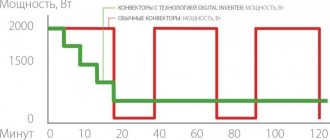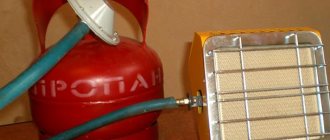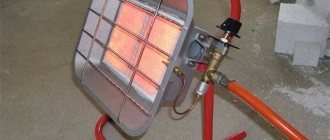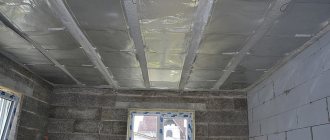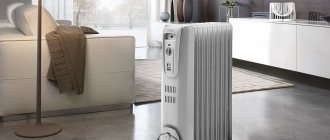In a garage, utility room at a construction site or small cottage, there is often a need to quickly warm up the room. For such cases, it is completely inappropriate to think about stationary heating. It is more practical to use a powerful and efficient portable heater that can quickly warm up a room or make being in it as comfortable as possible. Gas garage heaters from a cylinder have proven themselves to be the best, but you should familiarize yourself with their varieties to determine the most suitable option for a particular situation.
All gas heaters operate on a similar principle; the heat source is the active combustion reaction of methane, propane-butane, but the methods of transferring heat from the combustion chamber to the consumer differ. The main division is between infrared and convection designs.
Gas heaters are capable of delivering high thermal power with low fuel costs and compact dimensions of the device itself. Among the models presented on the heater market, there are devices with a power from 1.5 to 10 kW and even higher, which is enough to warm up a large shopping pavilion, an indoor sports ground or a large garage for several cars. Gas consumption in this case is approximately 100-300 ml of liquefied gas per hour for a 3.5 kW heater.
When purchasing a gas heater, you should always remember that its use always involves an increased risk of fire. In addition, portable devices are not equipped with a chimney to remove combustion products; over time, the oxygen in the room is burned out, and the concentration of carbon dioxide increases, which will affect the well-being and health of people. A mandatory requirement when operating a gas heater is constant and active ventilation of the room.
Infrared
Thermal energy is transmitted mainly by radiant energy, infrared radiation emanating from the heating device. In this case, it is not the air that is heated first, but the objects in the room or area of the heater. The radiation is easily directed using mirrors and reflectors in the desired direction, without wasting heat. Heating of the room is not accompanied by active air convection, which is perfect even for open areas and rooms with active ventilation.
The source of radiation can be either an open flame or surfaces heated to a high temperature. Thus, the following types of infrared gas heaters have become widespread:
- ceramic;
- catalytic combustion.
At the same time, these two types differ in the way they burn gas. In ceramic, the combustion process occurs inside a protected chamber. In catalytic combustion, open combustion occurs over the entire working surface, and additional protection is required. However, the catalytic burner is often made in the form of a ceramic plate.
Ceramic
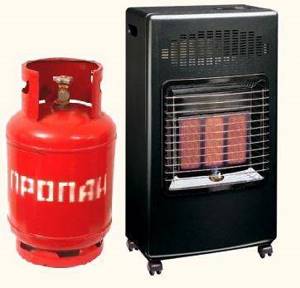
The preparation of the gas-air mixture and its combustion occurs in an insulated chamber, preventing the flame from escaping outside. Most of the heat generated is transferred to the ceramic plate with a large surface area. Afterwards, energy is emitted from the outside of the plate in the form of infrared waves. The composition of the ceramic plate and its shape are selected so as to increase the share of thermal radiation and reduce the surface temperature of the heater.
The purpose of creating ceramic infrared heaters was to reduce the risks associated with the use of flame and explosive gas. The combustion chamber is reliably protected and equipped with additional protective equipment that will shut off the gas supply in any emergency situations. At best, the following protection components are available:
- Heater temperature control. Shutting off the gas supply when the surface of the plate overheats or, conversely, if for some reason the flame in the combustion chamber goes out.
- Position sensor. If the heater tips over, turn it off immediately. In many models, automation is responsible for this, which will turn off the gas supply if the position of the heater changes unacceptable.
- CO2 sensor. The heater turns off if carbon dioxide accumulates in the room above the permissible limit.
Ceramic gas heaters cover the entire power range from 0.5 to 15 kW available for portable devices, they are safe and reliable in operation. However, their cost is higher than their catalytic analogues.
Requirements for energy-saving heaters
To install energy-saving heaters, you must familiarize yourself with all the requirements. Below are the operating rules:
- Before installation, you need to determine the minimum electrical energy consumption to generate one unit of heat.
- Fire safety. According to this rule, the requirements for all heating devices remain unchanged.
- Electrical safety. The heating device will operate around the clock, so garage owners must ensure that the wiring is intact.
- Easy maintenance during operation. It is necessary to perform preventive inspection and maintenance of the device at certain intervals.
They can be moved around the room during renovation work.
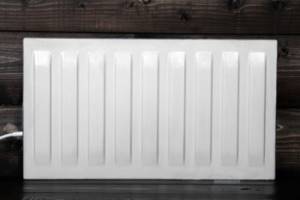
Heaters must be safe to use
Convection
Convection gas heaters stand out as a separate group. Natural gas or propane-butane from a cylinder is burned in a closed combustion chamber. The outer surface of the chamber forms a radiator with a large heat exchange area, through which the air is actively heated. To protect the combustion chamber, as well as create a channel through which air will move, the heater has a metal casing.
On the heater body, like any convector, there are slots in the lower and upper parts for air access. The heated air from the combustion chamber rises up and exits through the upper slots, making room for cold air entering from below. This maintains constant air convection inside the convector, which promotes mixing and heating of the air in the room.
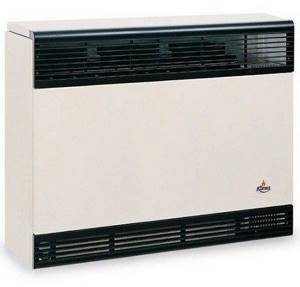
This type of heater for a garage with the door wide open is unlikely to be effective. If the air exchange rate is high, it will not have time to warm up and the room will still be cold. But a gas convector will be indispensable in garages, construction sites or inside a small country house, where only ventilation is used and there are no strong drafts.
With convectors, air to support combustion is most often taken from the street and combustion products are discharged there, which eliminates any problems with burning oxygen indoors and the risks of carbon monoxide poisoning.
Another feature of convectors is that it takes more time to warm up the room, but with less gas consumption. Together with increased safety and an electronic control unit, such a heater will be an ideal solution for maintaining a minimum temperature in the garage at +5 to prevent freezing.
Criterias of choice
It is important to choose a gas stove for a garage taking into account the main characteristics. Let's look at them in more detail.
Power
This characteristic will allow you to save not only on the purchase of the optimal stove option, but also during operation. A powerful stove will heat the room faster, but gas consumption will also be higher. A low-power stove will not be able to heat the room. Therefore, it is important to know even approximately the required power of the equipment to heat your garage.
You can calculate this characteristic yourself. To do this, you will need to determine the volume of the entire room and the cubic capacity of the gate. Multiply these values by the coefficients for the materials from which the garage itself and the gate are made. The resulting result will be the approximate power of the heating unit.
Material
This characteristic affects the longevity of your stove. When purchasing, you will need to familiarize yourself with the thickness and grade of steel of the body and firebox. When using structural steel, the thickness of the firebox sheet should be from 6 mm. It is better if heat-resistant steel or alloys were used in heat guns or convectors for the production of the body and grilles.
Alloy steels with a high content of chromium, silicon, and molybdenum are the best option for the production of parts exposed to high temperatures. Another option for a material that is not exposed to aggressive environments is stainless steel.
Winter summer
If the use of heaters is planned to be short-term and during the warm season, there is no point in buying expensive, powerful equipment. Small heat guns or convectors or a homemade stove that burns gas in a closed chamber will help here.
For winter and low temperatures, you will need to purchase a powerful gun or several infrared heaters and install them throughout the room. At this time, the efficiency of technology is an important factor.
Price
In this matter one should not go to extremes. You can’t try to save money and buy low-quality Chinese equipment for pennies and throw it away after a short time. But you shouldn’t buy an expensive, powerful heat gun from leading manufacturers to heat a small garage during short visits.
It is much more important to select equipment based on price and quality ratio. This is the only way to purchase good, productive gas-powered equipment for your box.
Other factors
Other factors include:
- level of environmental safety. The equipment should not harm consumers by releasing toxic substances when heating low-quality materials. Therefore, when purchasing, be sure to check the quality certificate;
- quality of garage stoves. Here you can determine who made the technique simply. Run your hand along the edges of the metal and if you find burrs, it means that your stove was not made in production. Pay attention to the quality of the paint coating, it will immediately show the experience and qualifications of the manufacturers;
- Pay attention not to the brand, but to the characteristics of the heaters. You will have to overpay for the name of an advertised company, although even the BOSCH brand is produced in 300 countries around the world. Before going to the store, go to forums on the Internet, here you can get reasoned and truthful advice.
Price
The range of gas heaters includes models for garages. They are compact, easy to connect and maintain, and do not require electricity. In order of increasing price, it is enough to define three groups:
- Gas catalytic burners are the simplest design, with minimal protection. The cost ranges from 800-2500 rubles.
- Infrared heaters with a catalytic burner - the presence of a housing, a convenient grip or stand, compact dimensions and often directed action. The cost ranges from 1300-4500 rubles.
- Ceramic heaters - presence of a housing, directional action, safe temperature of the heating element, protective grille and reflector. Price from 2500 rub.
| Name | power, kWt | Type | price, rub. |
| Solar gas GII 2.3 | 2,3 | ceramic | 810-900 |
| Neoclina UK-04 | 3,7 | catalytic | 1100-1340 |
| "COMFORT" GO-3.5 kW | 3,5 | catalytic | 1300-1640 |
| Elitech TP 3GI | 3,2 | ceramic | 2730-2900 |
| NeoClima UK-02 | 3,7 | ceramic | 2890-3500 |
| Timberk TGH 4200 SM1 | 4,0 | ceramic | 4500-4650 |
| Gas oven Hyundai H-HG1-42-UI577 | 4,2 | catalytic | 5720-5900 |
| Caliber GKO-4200 | 4,2 | ceramic | 7020-7300 |
Features of a homemade design
The main task that the future homemade device will perform is heating a room, tent, garage and other premises. When assembling it yourself, the appearance of the device and its decorative qualities fade into the background.
An important role will be played by the sufficiency of the amount of heat generated, the safety of operation and the ease of transportation of the device.

For heating purposes, a variety of homemade gas structures are used. Making heaters from gas burners or gas stoves with your own hands is not difficult. For quick assembly, you will need a pre-prepared diagram, the material from which the heater will be made, and a variety of tools.
Often a homemade gas heater is taken on a camping trip outside the city or on a fishing trip, on trips, to various gatherings as a source of additional heat. In such cases, it will be enough to assemble the device, check its functionality, inspect it for leaks and proceed directly to heating.
Sometimes a homemade heater is planned to be used as an alternative heating source. For example, in a country house, in a barn, in a paddock, in a garage and in other premises in order to save money on utility bills and on the purchase of gas equipment.

Often the prototype for the manufacture of a mobile gas heater is gas infrared burners and factory-made tiles
In such cases, care must be taken to minimize heat loss within the heated room. This is done by insulating the external and internal walls, floor and ceiling of the structure. It is most effective to carry out simultaneous internal and external insulation procedures. Then the heat will last as long as possible, and gas consumption will be much reduced.
If it is not possible to carry out two types of insulation at the same time, then you need to insulate the building at least from the inside. It's more efficient. When carrying out the procedure, it is necessary to use a material suitable for thermal insulation, as well as fire-resistant materials and coatings.
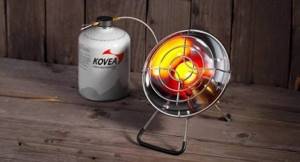
Insulating the heated room significantly reduces heat loss. In such rooms, the heating device will not work in vain, and, therefore, the user will not spend extra money on buying gas
When using gas equipment, you must always observe safety precautions and adhere to the rules for installing equipment and insulating premises. If a heated building is finished with fireproof materials, then it will be fire resistant. This significantly reduces the risk of fire and unexpected fires.
It is best to place a homemade gas heater in the center of the heated room. In this case, the generated heat is not lost or absorbed by the walls, since there is no contact with them. Warm air will go up to the ceiling of the room. If you also install special reflectors on the ceilings, the effect of a thermal cap will be created in the room.
This positive phenomenon allows you to significantly save money on space heating using homemade gas structures. Warm air circulates throughout the space and does not leave it. It is worth knowing that the heat cap effect is created when the heater emits a sufficiently intense air flow.
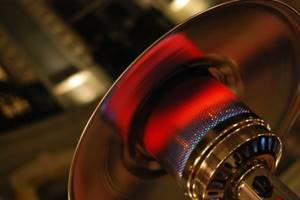
The main quality that a home-made device should have is safety of operation. If there is a leak while using the heater, you must immediately stop the gas supply.
Based on the results of assembly, a homemade heating device should have the following parameters:
- safe and easy operation;
- economical consumption of energy resources, in this case gas;
- efficient and fast heating of rooms;
- quick start of the device, possibility of long-term operation;
- ease of assembly and ease of replacement of failed parts;
- possibility of transporting the device;
- sizes convenient for carrying, transportation and operation.
All of the above characteristics are quite difficult to fit into one design. However, some craftsmen manage to independently make a gas heater of sufficient power, convenient, easy to use, which serves the user for a long time.
The advantages of homemade gas heaters include:
- Economical work. Sometimes one full cylinder can be enough for 12 hours of continuous operation of the device. Of course, it all depends on the size of the cylinder.
- Ability to quickly turn on and off.
- Compact and light weight. Some homemade designs are convenient to take on hikes. They do not take up much space and weigh several kilograms. And the beneficial effect of their use is difficult to underestimate.
Among the disadvantages of homemade designs is the need to select a suitable cylinder or have an adapter. Therefore, you need to take care of purchasing additional cans in advance. Or be able to transfer gas from a large cylinder into a small tank.
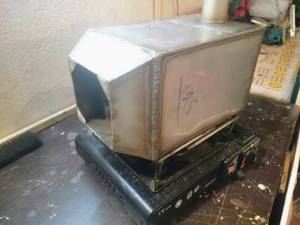
The heat exchanger is an important structural part of the heater. It is a steel box with welded pipes passing through it. The heat exchanger is installed in a metal casing. A fan is also installed
Some self-made gas heaters cannot withstand severe subzero temperatures and will not start if the air temperature is below a certain level. Facing such a problem can overshadow a tourist trip. However, indoor temperatures usually do not drop to very low levels.
If the heater operates indoors, it is necessary to ensure the supply of fresh air. It is also important to consider that the level of carbon dioxide indoors increases. Air humidity decreases significantly.
Do not leave the device turned on unattended, or bring flammable objects near it. This may cause fire and ignition.
The operating efficiency of a self-constructed device is determined by its main characteristics.
Efficiency. This indicator is determined by the ratio of the energy that is used for heating to the energy that is spent to generate it. Gas heaters have different efficiency values.
Device safety. Often, on home-made structures, the installation of devices that ensure safe operation is neglected: valves, sensors that automatically turn off the burner.
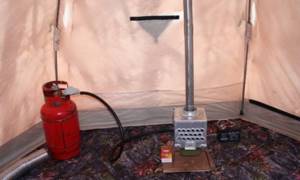
The operation of this device is as follows. The burner heats the inner tubes. The air that comes in from outside is heated by the tubes and becomes hot at the exit. The exhaust pipe removes carbon dioxide from the room
Fuel consumption and area heated by the device. Depending on the size of the device, fuel consumption also changes. The larger the room, the larger the burner will be required.
Is it possible to heat a garage with an IR heater?
A special feature of the equipment is the use of IR rays for heating. As a result, it is not the air in the room that heats up, but the surface of objects located next to the installation. A person feels warm immediately after turning on the unit. With the help of IR emitters, it is quite possible to heat both a small and capacious box.
Infrared gas heater for constant heating of the garage is intended for premises used as automobile workshops. The performance of the gas installation is quite enough to create and maintain a comfortable temperature. If you install a programmable thermostat, you can automate the heating process as much as possible and reduce costs by approximately 40-50%.
Provided that there is no need to heat the garage itself, installations for spot, local heating with a power of approximately 1 kW are chosen.
Practical gas burner for heating a room: how to choose a heater
A common method of heating garages is heating with a gas burner. Fuel is usually supplied from small gas cartridges, since such a heater is usually intended for cooking food, and not for heating a room. Also, the burner may simply be part of some more powerful heating device.
In any case, any burner receives heat from an open source of gas flame, which is associated with a certain danger. Therefore, when installing such equipment, safety precautions should be observed.
What not to do when using gas heaters:
- Dry things on it;
- Direct a hot air stream at easily flammable objects and substances;
- Do not use the protective grille;
- Refill cylinders yourself.
Also, the room must have high-quality ventilation so that decay and combustion products do not accumulate in the air, poisoning it.
When choosing a heater for a garage, you need to consider its type and for what purpose it is purchased:
- For frequent use, an economical gas convector is suitable, which can be used even when people are constantly in the garage;
- Infrared burners are designed to quickly warm up a room if necessary, for example, for car repairs;
- Also a good solution for a small garage would be a catalytic heater, which is easy to connect and can be installed almost anywhere.
When using a convective radiator, you need to remember that for its safety to be used, there must be ventilation in the garage and the doors of the building must be closed.
Types of garage IR heaters
In the garage you can install infrared heaters running on electricity and gas, industrial and domestic type, used as general or local heating.
Industrial IR emitters
The main purpose of the units is to heat rooms with ceiling heights from 3 to 8 m. They are optimally suited for heating garages, car service centers, car washes, tire service centers and private auto repair shops. They run on electricity, diesel fuel and gas.
There are several types of installations:
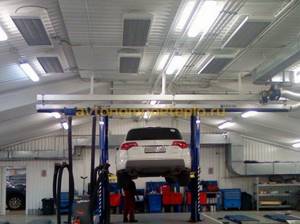
In addition to these features, when choosing an industrial installation, you should pay attention to the radiation characteristics. For a garage, it is better to choose wall-mounted infrared heaters using long-wave radiation.
Household emitters
Heating a garage using a household-type infrared heater is especially popular. The installation is used for local heating. Often the emitter is installed directly above the hood of the car. Even with a strong drop in temperature, the engine will not freeze, so starting the car will be much easier.
You can use ceiling-mounted infrared heaters to heat a garage, as well as portable models on tripods, as a local or general heating system. Some modifications are specially manufactured in the form of ceiling panels built into the cladding.
Heat guns
The popularity of devices of this type among garage owners is explained by the high rate of heating of the interior space. Gas heat guns with a built-in fan also require electrical power. Models without fans work thanks to the draft from gas combustion. Regardless of the type of propane heater used, the level of insulation of the garage building is of great importance.
Similar articles
- Gas liquefaction: features of technology and transportation
- Scope of application of gas rotameters
- Strengths and weaknesses of gas cylinder heating systems
Which brand of IR heater is best to put in the garage?
Wall mount electric infrared garage heaters offer:
- UFO.
- Daewoo.
- PEONY.
- EcoLine.
- Mr. Hit.
- Infra.
- IcoLine.
It’s quite easy to warm up your garage in winter using heaters of these brands. The simple design allows you to do the installation yourself. The package includes brackets for mounting to the wall or ceiling of a room. Household devices have a small power of up to 2 kW.
The efficiency of an industrial IR heater is significantly higher. One installation is enough to heat rooms from 80 to 100 m³. If necessary, several units are connected to a single network with one or more thermostats.
Automated heating systems are manufactured by large manufacturers of climate control equipment:
- Heliosa.
- Hyundai.
- Zilon.
- Starprogetti.
Life far from the equator dictates its own laws. As the outside temperature drops, the houses inside also cool down. In this review, we will consider a solution to the problem by choosing the best gas heaters - from portable ones (for a tent) to convectors for a home or cottage, which can replace a gas boiler.
DIY infrared burner: manufacturing methods
An infrared heater is often used to heat garages or other utility rooms.
Among the advantages of such a heater:
- Cost-effective;
- Reliability;
- Compactness and mobility;
- Long term of use;
- Quick heating of the room.
An infrared burner heats surrounding objects, and they release heat into the room. Everything is simple and fast.
In a garage, the heat flow is most often directed towards the floor, so installation occurs in the ceiling area.
Methods for making an infrared heater:
- Upgrade an old radiator. To do this, you need to use aluminum foil as a reflector, which is fixed on the wall. Reflecting from the foil, the heat will spread throughout the garage.
- Mix epoxy glue and graphite. Apply the resulting solution onto the sheets of laminated plastic in zigzag lines so that when gluing the sheets together they touch each other. Next, you need to connect the electrical wires from different sides to the plates on copper terminals. The heater is ready. The heating power can be controlled by a regulator.
Types of gas heaters
Gas convectors
Such heaters can have a closed or open combustion chamber. Closed-type models for gas combustion take air from the street and discharge combustion products there through a special pipe laid through the wall. They are well suited for a home or cottage and can become an alternative to a gas boiler. Models with an open combustion chamber are not very suitable for residential premises or require the use of a vertical chimney.
Catalytic gas heaters
Devices of this type operate by oxidizing substances on the surface of the catalyst, which releases a large amount of heat. The process occurs almost silently and without flame. The catalytic combustion method is more reliable, efficient and safe compared to that used in conventional infrared heaters.
Ceramic gas heaters
By analogy with their electric counterparts, such heaters operate due to directed thermal radiation and heat not the air, but the surfaces of walls, objects, and also people present in the room. The only heating source is a gas burner. The use of ceramic plates allows for complete combustion of fuel and eliminates harmful emissions.
Thermal gas guns
They have a cylindrical shape and operate on the principle of a fan heater, in which the role of a heating element is performed by a gas heat generator. They are powered by bottled gas, and the power is usually regulated by a gearbox.
Read more about the best models of gas heaters of different types in our rating:
| Category | Place | Name | Rating | Price |
| The Best Gas Heaters for a Garage | 1 | Solar gas GII 2.9 | 10 / 10 | 950 |
| 2 | Caliber TPG-10 | 9.8 / 10 | 4 140 | |
| Best Portable Gas Heaters for Tents | 1 | Pathfinder Ion PF-GHP-S01 | 9.8 / 10 | 3 790 |
| 2 | Kovea Fire Ball KH-0710 | 9.7 / 10 | 6 290 | |
| The best wall-mounted gas convectors for the home | 1 | Alpine Air NGS-20F | 9.8 / 10 | 20 700 |
| 2 | heater Hosseven HP-3 | 9.8 / 10 | 24 300 | |
| The best outdoor gas heaters | 1 | Enders Elegance | 10 / 10 | 21 550 |
| 2 | Ballu Bogh-14E | 9.8 / 10 | 39 990 | |
| The best mobile gas heaters for home and garden | 1 | Bartolini Pullover K | 10 / 10 | 10 700 |
| 2 | Timberk TGN 4200 SM1 | 9.7 / 10 | 5 389 |
Street products
Master Leto ML-5
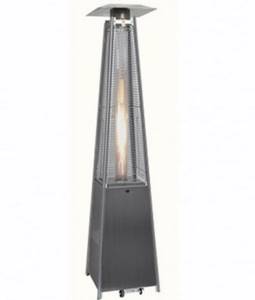
The device is available in several colors and operates on the principle of infrared heating, which makes it very suitable for use in outdoor conditions - verandas, terraces, cafes, and so on. The case is high quality and reliable, retaining its original appearance for a long time. Products from this company have been on the market since 2003, and during this time they have proven themselves to be extremely reliable. The manufacturer provides a long warranty for its products - as much as 3 years. The product is made in the shape of a pyramid, perfect not only for additional heating, but also for lighting.
Such a device emits a soft and slightly fluctuating glow, which, in turn, allows you to create a comfortable environment and evoke a feeling of comfort. The largest heated surface area is 4 meters in diameter. The body is made of reliable polished steel, coated with powder paints, and is ignited using piezo ignition. The glass bulb acts as the main heat emitter here. The height of this lamp is 2.25 m, the power rating is from 4 to 8 kW. The design can use liquefied propane or butane, the consumption is not very high: it can reach a maximum of 0.87 kg per hour. The lamp itself weighs 24 kg and is quite stable, so you won’t be able to accidentally drop it or move it while passing by. It is permissible to install a cylinder with a volume of 27 liters; the lamp will completely use it up within 31 hours of continuous operation at full power.
More: TOP 10 thermostats for heated floors
Advantages:
- Smooth power adjustment;
- Very beautiful appearance;
- Decent heated area;
- A thermocouple is installed that will shut off the gas supply in case of attenuation;
- Easy to use, easy to connect;
- Wide base provides excellent stability.
Flaws:
- The kit could include a stabilization container and legs for fixing to the floor.
Master Leto ML-5
NEOCLIMA 09HW-B

The gas model for outdoor use is housed in a high-quality stainless steel case, which will retain its original appearance for quite a long time - it will not have to be repainted. It is quite enough to periodically clean the surface of the heater from dust and other accumulated contaminants. This can be done with an ordinary damp cloth or use detergents, but the manufacturer does not recommend using abrasive materials. The power of the equipment is very high, as evidenced by the decent range of the device - it reaches 5 meters, it will not take time to reach operating temperature.
If the air temperature has not yet completely dropped, then you can use a special smooth adjustment to change the power indicator. To turn on the heater, just press the piezo ignition button. The heater can be used for a long time without causing any danger to users. The model is equipped with a number of sensors, including flame control and a sensor that protects against overheating. There is another sensor - a fall; if the device is tilted at an angle of 45 degrees, the emergency protection system will work, which will turn it off. You can connect almost any cylinder, but under the body there is space for a product with a volume of 27 liters.
Advantages:
- Simplicity of the device;
- Long service life;
- High quality materials;
- Absolute safety of use.
Flaws:
- It is difficult to remove the protective film that covers the heater body.
NEOCLIMA 09HW-B
Aesto A-02

The device is housed in a mushroom-shaped case and has a very beautiful appearance. This is a modern design, which is designed exclusively for use outdoors - in the garden, on the lawn, in open areas of cafes and restaurants. It appeared on sale not too long ago, but due to the presence of a large number of useful characteristics, these models have become quite attractive. The body of the product is made of high quality stainless steel. The heating element is very reliable and absolutely safe. This design is perfect for areas with high humidity levels; the user will not have to worry about its performance if precipitation suddenly begins.
The heater is designed quite simply; if necessary, it can be quickly disassembled, it is not too heavy, and there are wheels at the base for moving around the site. When disassembled, it will fit even in a small car trunk. The device easily heats surrounding objects; its operating area is 25 square meters. The product can be used at any time of the year. The device is designed to operate on bottled gas - a cylinder with a volume of 27 liters is placed in the rack. Fuel consumption is economical: one gas refill is enough for approximately 30 hours of continuous operation. The heating power ranges from 5 to 13 kW.
Advantages:
- High level of power at an affordable price;
- Special attention is paid to safety - not a single element is heated, so people cannot get burned;
- The weight of the device is only 17 kg;
- Easy to install, disassemble and transport;
- Attractive appearance.
Flaws:
- A gas cylinder is not included with this product.
Aesto A-02
Ballu BOGH-15

This is truly the best model, which is designed for use directly in open air conditions. The set of operational characteristics here is optimal, the model is simple and convenient to use. Largely thanks to these properties, this heater was able to take the leading position in our rating. At the same time, it is not only functional, but also quite effective, and also meets all the necessary requirements in the field of safety and environmental friendliness of operation. The heater is started using the electric ignition button, which is located directly on the body of the model. In a glass flask that is resistant to high temperatures, the flame height can be about one and a half meters.
The principle of operation is the same as that of the other models that are included in this section of our rating of the best gas heaters of the year. The maximum heating radius is 3 meters with a heating area of about 28 square meters. The device is absolutely safe to use. Its design includes several sensors that will turn off the gas supply if an emergency situation occurs. Metal surfaces will not heat up to extremely high temperatures, so it will simply be impossible to get burned on them. The pyramid is positioned steadily; there will be a gas cylinder at its base. The weight of the lamp is 40 kg, there are several wheels at the bottom, and the turned on heater looks very impressive.
More: Top 10 varieties of cherry tomatoes
Advantages:
- Very stable pyramidal structure;
- Many sensors are responsible for the safe operation of the heater;
- Beautiful appearance, which will look even more impressive in twilight and darkness;
- Excellent build quality.
Flaws:
- You will have to install wheel chocks.
Ballu BOGH-15
The Best Gas Heaters for a Garage
The infrared gas burner Solarogaz GII-2.9 is designed for local directed heating of rooms with a lack of free space. It can also act as a small stove for heating or cooking. The device can also be used for drying surfaces during painting work. The main advantages of Solarogas GII-2.9:
- The design uses a Raushert ceramic emitter (Germany), which ensures reliable and durable operation of the device and uniform flame distribution;
- High efficiency due to direct and secondary (due to heated surfaces) thermal radiation;
- Autonomy. The burner does not need to be connected to the mains;
- Economical. An inexpensive type of fuel (propane) is used and gas consumption is kept low;
- Silent and safe operation (no open flame);
- Light weight (no more than 2 kg) and mobility.
The presented model has a power of 2.9 kW. If the need arises, you can find analogs for 2.3 or 3.65 kW.
Setting up the control unit and connecting power
Let's move on to connecting the control unit and power wires. Attach the plastic display pad to a convenient place with screws.
At the top of the display is a sensor that measures the current temperature in the garage. Be careful not to damage it or cover it with anything.
Otherwise, you will not be able to get the device to work correctly. Connect the wires from the control box to the pump and heater through special contact chips. It's difficult to confuse them.
The thickest is the power wire, which must be connected either from a battery or from a 12V power supply.
Similar ones are widely used for LED strips.
The current consumption of the Chinese Webasta heater at startup reaches 10A. Therefore, it is better to take a powerful unit with a reserve of 250-300W.
If you don’t want to buy a separate unit, then use a charger connected via the battery and the network.
This thing will never be useless in any garage.
More details
Is it possible to connect this Webast only from the power supply, without a battery? No, not recommended. It is advisable to use them in parallel connection.
Otherwise, if the light suddenly goes out, the heater will simply burn itself out from the inside. In normal mode, when you turn it off with the button, it first cools all its internals, extinguishes the flame, and only then completely and correctly turns off the fan and turns itself off.
Therefore, it is necessary to have a battery if you want the device to work for a long time and properly.
The main question that interests many is how long will the battery last? As real tests have shown, for a 90-amp battery, the heater lasts for 10-12 hours of continuous operation. Well, in general, roughly assume a maximum current of 10 A/h.
After applying voltage and pressing the power button, the display lights up.
What functions does it have, how to manage it? Press the "OK" button - the temperature is displayed.
Press “OK” again - the power set on the heater is displayed.
It can be reduced or increased using the up and down buttons on the right side.
Next comes the current voltage of the on-board network from the battery or power supply.
This is followed by error codes.
You can see what they mean from the table below.
After the codes, the time is displayed and all functions are repeated again.
Advantages and disadvantages of IR
Garage IR heater equipment, technical indicators and features of use have specific advantages and disadvantages.
Advantages:
- connecting equipment does not require large financial investments;
- the basic package consists of the necessary parts for installation;
- simple connection of an electric emitter;
- installation of gas equipment may require obtaining the necessary permit;
- the possibility of separate zones of the room, rather than the entire garage;
- modern models are protected against overheating of the surface and fire in the event of a fall.
Minuses:
- the power of household appliances is much reduced in order to obtain favorable heating conditions;
- the high cost of the device and the large number of Chinese counterfeits that fill the climate system market.
The IR heating system has no analogues. Compared to a standard heating radiator, they allow you to get instant heating even in a cold building. High efficiency and almost no significant disadvantages explain the popularity of infrared emitters.


